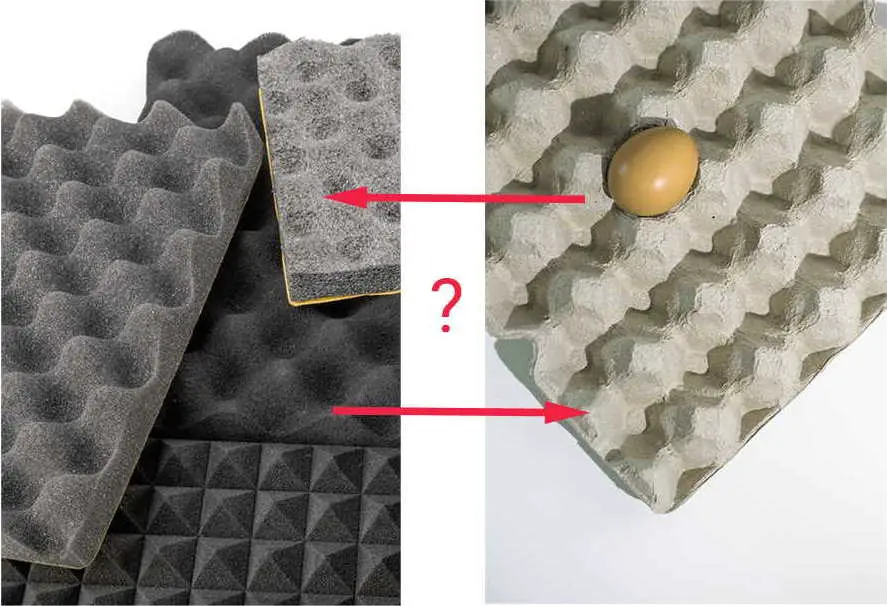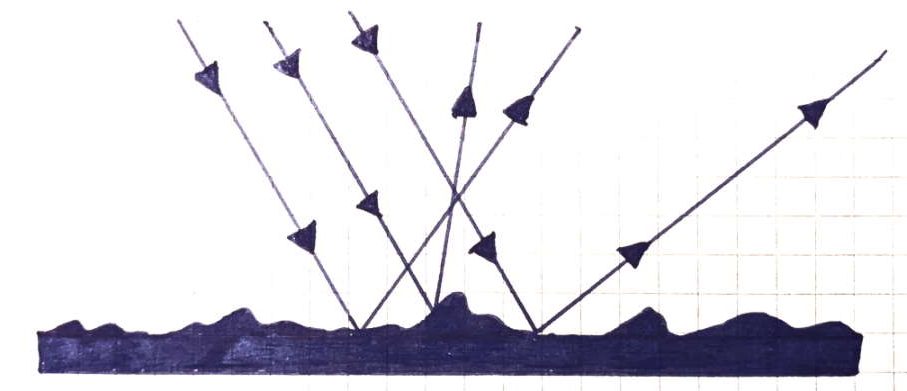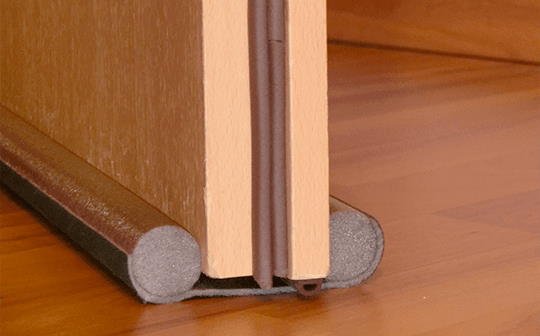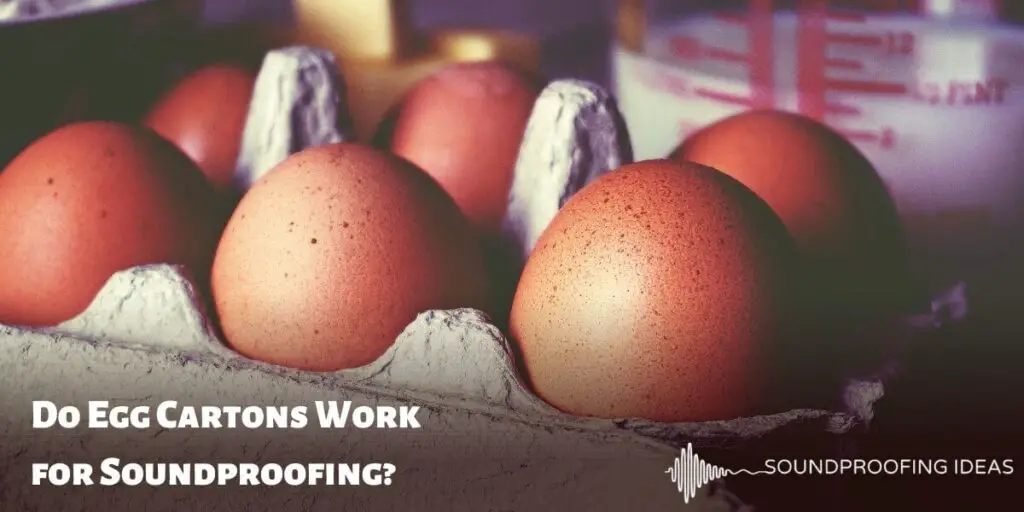If you’re just looking for an inexpensive way to soundproof a room, sooner or later you will likely come across the popular idea that empty egg cartons can be used for this purpose. You just attach them to the door or wall and you’re done.
But is this method really effective or is it just a myth? Learn the truth here before you start buying more eggs than you can use over the next three years and turning your walls into a waste paper collection.
Glue egg cartons to the walls to make the noise quieter next door. You have probably heard this advice before too. On the other hand, I read at least as often that egg cartons are not supposed to dampen the sound at all.
Therefore, I have devoted myself very intensively to this topic. The result: the truth lies somewhere in between. They do have an effect, but they don’t necessarily do what you might hope for.
The fact is that egg cartons have a verifiable sound-absorbing effect, but this has little to do with sound insulation (“make sound quieter.”) You can find out what effect they really have and what inexpensive alternatives to sound insulation are available here.
Professional soundproofing materials usually have one of two special characteristics. Either they have a high density or they are filled with innumerable small air chambers.
A high density (and therefore also a high mass) has the effect that sound waves are effectively stopped and simply ricochet off. One example of this are so-called mass-charged vinyl mats.
Alternatively, there are materials that do not have a high density, but are filled with an extremely large number of small air chambers. Acoustic foams are an example of this. When the sound reaches the air chambers, it causes them to vibrate and is thus converted into kinetic energy. This effectively dampens the noises.
A quick look at an egg carton is enough to determine that it has neither of these two properties. Instead, the cardboard is very thin and weighs only a few grams, and there are hardly any air pockets in it.
In fact, egg cartons are unfortunately hardly able to stop sound and are therefore not a good means of noise protection. Their material is simply too thin and too light and has no air chambers that could effectively dampen the sound.
But why are they still recommended so often? Is that a total mistake? – Not quite.
In some cases, egg cartons on the walls can have a positive effect on the room acoustics . So if it’s less about reducing the noise on the other side of the wall and more about improving the sound quality inside, they may still be worth considering.
Insulate sound or reduce reverb?
“Sound insulation” describes the process of preventing sound from getting from A to B, especially if there is a wall, door or similar between A and B.
“Reverb reduction”, on the other hand, happens when the echo of the sound is dispersed , which often means better sound quality in the room. Due to their special shape, egg cartons hardly have any flat surfaces. As a result, incoming sound is not reflected back to its original source, but is scattered in all directions. A wall that is stuck with egg cartons therefore has a significantly lower reverberation than a normal, smooth wall . This can be useful at times.
Contents
- 1. The myth of egg cartons against noise
- 2. Why can’t egg cartons dampen the sound?
- 3. What effects do egg cartons have on sound?
- 4. Which egg carton alternatives to sound insulation are there?
- 5. When does the use of egg cartons make sense?
- 6. If you still want to use egg cartons
- 7. Effective alternatives
1. The myth of egg cartons against noise
If you look at the common egg cartons, they certainly have similarities to the foams from recording studios. Then egg cartons should also be able to help dampen the noise, right?

Unfortunately, no. Please don’t be fooled by the similarity to foams. The shape has no effect whatsoever on what you most likely want to achieve with the egg cartons.
Again, just for understanding, to make sure we’re talking about the same thing. Sound insulation is used in the following scenario:
You generate sound (mostly in the form of music) at location A and want this sound to no longer be heard at location B. Place A can be your room, your apartment or your rehearsal room and place B is where your neighbors are, for example.
In this case (sound insulation), egg cartons unfortunately turned out to be unsuitable after acoustic measurements.
It’s not possible to really reduce noise with egg cartons. Egg cartons on the walls have practically no effect on sound insulation. It doesn’t get quieter outside the room.
2. Why can’t egg cartons dampen the sound?
Well, sound propagates through vibrations of the smallest particles in the air and in solid substances. With its energy, the sound tries to bring almost everything to vibrate on its way. Only through this resonance does the sound get from one place to another.
If the so-called medium through which the sound moves is very heavy, then it is all the more difficult for the sound to make the tiny particles of the medium vibrate. Another important connection should be mentioned:
Sound travels at many different frequencies. The low frequencies are the very deep bass-heavy and energetic tones, while the high frequencies represent the very high tones with less energy.
You’ve probably heard a loud conversation through a wall and noticed that it sounds a bit dull. This was because only the low frequencies could penetrate the wall.
Back to the egg carton. Since it is well known that an egg carton is not very heavy, it can hardly do anything to counter the sound. There are also experiments that clearly show what egg cartons can and cannot do. The result was similar in all examinations:
- Frequencies below 500 Hz show no influence at all from egg cartons.
- Frequencies from 500 to 1000 Hz are approximately 60% absorbed by egg cartons.
So can egg cartons stop the sound?
If only frequencies with a certain frequency around 1000 Hz are absorbed, the many other different frequencies are still present in this large listening area.
This is exactly where the crux of the egg carton lies: Above all, the low frequencies (below 150 Hz) simply penetrate the carton as if nothing had happened. Most of the time, you really want to stop these low frequencies.
Assuming a solid concrete wall in the rehearsal room is able to effectively stop frequencies from 100 Hz. You are now pasting the wall with egg cartons, which are demonstrably ineffective below 500 Hz. High frequencies are now absorbed by the egg cartons, but these frequencies would not have come through the wall anyway.
3. What effects do egg cartons have on sound?
Even if egg cartons do not ensure that the sound is stopped, they can still have an impact on the sound within the room. But how strong is this influence?
Whenever there is talk of the sound in the room itself, one also speaks of room acoustics. To improve the room acoustics , the sound in the room is changed. It is always about the sound inside the room and not whether the sound gets from the inside to the outside or vice versa.
Examples of room acoustics are:
- Furniture and carpets prevent hallways in an empty room.
- In the recording studio, the sound should be improved to enable good recording. For this purpose, special acoustic materials are installed in the studio.
In principle, egg cartons have an influence on the 3 following factors that change the sound in the room.
Sound reflection
Surely you know the sound of a room that is completely empty. It is extremely reverberant because the sound is very often thrown back into the room from the walls. This process is called reflection.
The reflection is very dependent on the nature of the material that the sound hits. It’s basically like throwing a ball first onto a concrete floor and then onto lawn. How the ball is thrown back to you depends on the material of the floor.
In a room with egg cartons on the walls, less sound is reflected than in a “bare” room with hard concrete walls. But here you hardly have any possibilities to control the reflection and, as already mentioned, only the high notes are influenced.
In addition, you could just as well stick a layer of normal cardboard on the wall and the effect of the reflection would be almost the same as with the egg carton.
Sound diffusion

The sound can break on uneven surfaces and split up in many small different directions and thus “scattered” back into the room. This is called diffusion. As a result, the sound is distributed more evenly in the room and sounds more pleasant and natural.
Due to the shape and width of the egg cartons, the sound that hits them is also scattered. The effect of the egg cartons, however, leaves something to be desired, since a controlled and adapted scattering is hardly possible here too and only occurs in the really high-frequency range.
In practice, diffusers are designed in such a way that their dimensions, i.e. their depth, result in very specific scattering. This is of course not the case with egg cartons and thus the effect is practically not really given. Egg cartons do not noticeably improve the sound in the room.
Sound absorption
Of course, absorption also plays a role in room acoustics and sound absorption. Any sound that has been absorbed or swallowed can no longer get into the room.
The absorption by egg cartons, as already described above for sound insulation, mostly takes place between 500 and 1000 Hz. This is neither really beneficial for sound insulation nor for sound absorption , because this area is simply too small.
4. Which egg carton alternatives to sound insulation are there?
It all depends on your goal. If you want to provide soundproofing, i.e. reduce the transmission of sound from one place to another, you could implement the following inexpensive methods:
Avoid sound bridges

In addition, all windows and doors should be really airtight, because the sound can spread wonderfully through the air. Seals for the doors and windows are helpful here. A draft stopper for under the door can also achieve a certain effect.
For less than 20 € you can simply cut seals to your own size and get a draft stopper and have thus already improved the weakest link in the sound insulation.
Sound barriers through mass

Heavy objects in the room provide appropriate sound insulation and can also absorb certain sound waves. Of course, it depends on your situation, but a large shelf or a massive cupboard in front of a wall can have a clearly audible effect.
Nubbed foam mats or other foams that do not really have a significant mass are practically ineffective for sound insulation. These can only be used, if at all, for the acoustics in the room and, like egg cartons, only absorb the high frequencies. [1]
If you get yourself a heavy molton curtain that you attach to the wall, you will certainly have better soundproofing than with egg cartons and it will also look better. However, you will not be able to stop frequencies in the medium to low range with this either.
Professional soundproofing
If you have a rehearsal room and do not want to disturb the neighbors or if you want to dampen other really loud noises, unfortunately you cannot avoid a professional solution. As already mentioned at the beginning, it’s about the really low frequencies that often cause problems.
Special broadband absorbers are helpful for room acoustics, but they cannot really absorb the low frequencies (<50 Hz) either. These low frequencies can really only be stopped by materials that have a high density and are therefore correspondingly heavy.
Only structural measures will really help. Replacing the door with a special soundproof door can bring small improvements here. You can also increase the mass of the door yourself by attaching a wooden panel to the door. You should then be careful with the hinges so that the door does not literally “fly” off its hinges.
The best way to soundproof a wall is with drywall. Here, plasterboard panels are fastened in a special metal fastening in front of the actual wall.
5. When does the use of egg cartons make sense?
A special case in which the use of egg cartons can make sense, for example, is when you want to set up your own recording studio without spending a lot of money. Because the cardboard boxes are well suited to reduce the reverberation in the room, which automatically makes audio recordings sound more high-quality and professional.
Of course, there are also specially made foams for this purpose, which fulfill this function a little better and, of course, look much better at the same time. You can get egg cartons free of charge and they can be helpful at least to get started.
6. If you still want to use egg cartons
If you should nevertheless use egg cartons as a means of reducing the reverberation, you will find 3 useful tips here on what to consider and how you can possibly get the most out of the cartons.
- Use two or even three layers on top of each other! Since egg cartons can be put together very well, you can easily use several layers of the cartons in combination. Just connect or glue them together.
- Put extra material between the layers. If you have a few old pieces of fabric left, you can put them between the layers of cardboard. This also improves the effect and absorbs a little more sound.
- Color the boxes! Ok, admittedly, this tip has little to do with soundproofing, but sometimes the eye can also somehow hear! Egg cartons do not make a particularly elegant impression. But with a little creativity and color, they can be made much more beautiful.
7. Effective alternatives
As already mentioned, egg cartons are a bit of a disappointment if you want to prevent loud noises from coming through a wall or door. Here are a few useful alternatives that can really keep the noise out and still not have to spend a lot of money .
- The door is often a critical weak point when it comes to noise protection and you should check if you can make it soundproof. To do this, you can, for example, seal the gap between the door and the floor with a strip.Another way to make the door soundproof is to replace the rubber seals on the door. This prevents air and therefore noises from moving unhindered between the door and the door frame.These two measures can work wonders and are also very cheap. A detailed explanation and additional tips on how to make your door soundproof can be found here: make your door soundproof .
- Hang thick blankets. Thick blankets on the walls or over the door are also significantly more effective than egg cartons. Due to their soft surface, they also reduce the reverberation and can sometimes even dampen the noise, especially if they are very thick and heavy. Soundproof curtains can also be a great option for this.
Conclusion
Unfortunately, egg cartons are hardly suitable as a material for soundproofing. They’re just way too light and don’t have any air pockets to effectively stop the noise. However, their special shape means that the reverberation within a room is reduced. So when it comes to improving the sound quality in the room, egg cartons can sometimes be worth considering. In most cases, however, one should resort to more effective alternatives.
Summary
- Sound insulation is the blocking of sound from one place to another and is usually associated with structural measures.
- Sound attenuation, on the other hand, describes the improvement of the sound in the room itself and not whether sound is coming from the outside to the inside or vice versa.
- Egg cartons have been shown to have no effective effect on sound insulation.
- However, egg cartons can affect the soundproofing.
- Noise attenuation by egg cartons only takes place at high frequencies and cannot really be controlled.
- As a result, medium and high tones remain unaffected and the sound in the room becomes unbalanced

